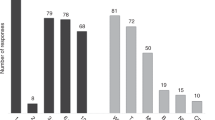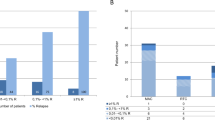Abstract
The monitoring of chimerism by PCR has become a routine diagnostic approach in patients after allogeneic bone marrow or peripheral blood stem cell transplantation. Nevertheless, a temporal correlation between molecular and hematologic assessment of engraftment has not been clearly established. To address this issue, and to determine the potential clinical implications of early kinetics of mixed chimerism, we have investigated 66 allogeneic stem cell transplantations (SCTs) in 58 pediatric patients suffering from different types of leukemia (n = 44) or non-malignant hematologic disorders (n = 14) by close molecular monitoring during the first days and weeks after transplantation. Patient- and donor-derived hematopoiesis were assessed at 1- to 3-day intervals in peripheral blood samples by PCR analysis of highly polymorphic microsatellite loci (STR-PCR). Detection of an increasing, and ultimately dominant donor-specific allelic pattern, which we defined as molecular engraftment, preceded hematologic engraftment by a median of 7 days (range 1–17 days) in all patients investigated. PCR analyses during the first days after transplantation facilitated detection of molecular engraftment according to the above definition by day +14 (range day +2 to day +14), thus permitting prediction of successful engraftment (upper limit of the two-sided confidence interval po = 6%) while the peripheral leukocyte counts were mostly below 200/μl. In three cases, however, the criteria for molecular engraftment were not fulfilled by day +14. These patients also failed to show hematologic engraftment, and required a second transplantation. Close monitoring by STR-PCR showed that graft rejection and autologous recovery can occur early and with very rapid dynamics. Molecular analysis of specific leukocyte subsets isolated by flow-sorting enabled sensitive assessment of changes in the pattern of chimerism which had escaped detection in assays using whole white blood cell (WBC) samples. This approach facilitated the identification of expanding or decreasing recipient cells, and permitted early detection of impending rejection or relapse. Moreover, monitoring of the dynamics of chimerism allowed rapid assessment of the response to therapy. Our observations provide support for the concept of initiating genotype analyses early after SCT and monitoring at rather short intervals to permit timely evaluation of clinically relevant processes, and to provide a basis for early implementation of treatment.
This is a preview of subscription content, access via your institution
Access options
Subscribe to this journal
Receive 12 print issues and online access
$259.00 per year
only $21.58 per issue
Buy this article
- Purchase on Springer Link
- Instant access to full article PDF
Prices may be subject to local taxes which are calculated during checkout
Similar content being viewed by others
Author information
Authors and Affiliations
Rights and permissions
About this article
Cite this article
Dubovsky, J., Daxberger, H., Fritsch, G. et al. Kinetics of chimerism during the early post-transplant period in pediatric patients with malignant and non-malignant hematologic disorders: implications for timely detection of engraftment, graft failure and rejection. Leukemia 13, 2060–2069 (1999). https://doi.org/10.1038/sj.leu.2401603
Received:
Accepted:
Published:
Issue Date:
DOI: https://doi.org/10.1038/sj.leu.2401603
Keywords
This article is cited by
-
Implications of hematopoietic stem cells heterogeneity for gene therapies
Gene Therapy (2021)
-
Expansion of donor-reactive host T cells in primary graft failure after allogeneic hematopoietic SCT following reduced-intensity conditioning
Bone Marrow Transplantation (2014)
-
Early peripheral blood and T-cell chimerism dynamics after umbilical cord blood transplantation supported with haploidentical cells
Bone Marrow Transplantation (2014)
-
Early recipient chimerism testing in the T- and NK-cell lineages for risk assessment of graft rejection in pediatric patients undergoing allogeneic stem cell transplantation
Leukemia (2012)
-
Immunosuppressive Properties of Mesenchymal Stem Cells
Stem Cell Reviews and Reports (2012)



